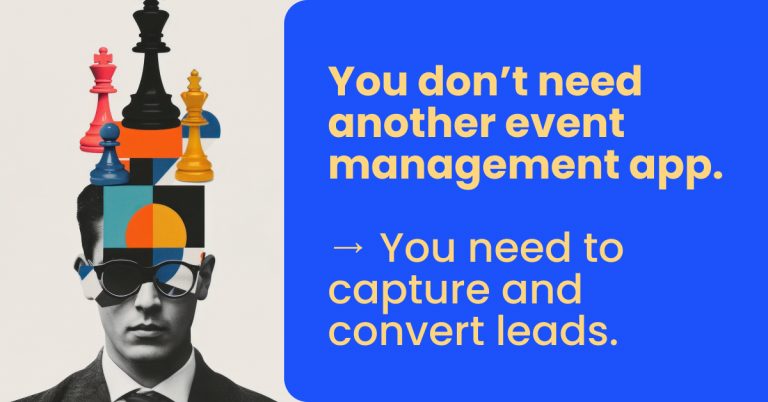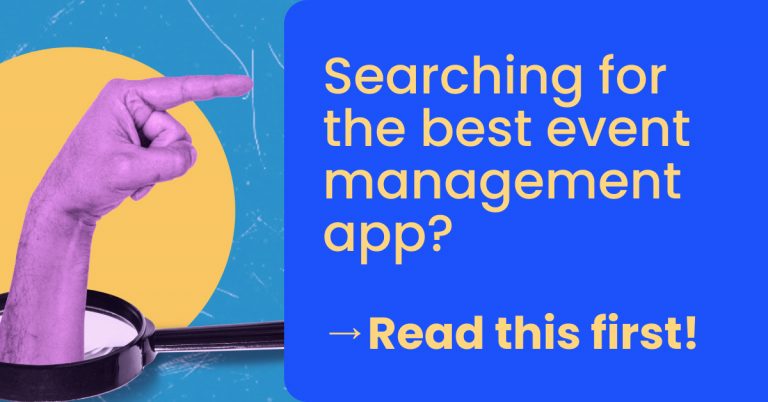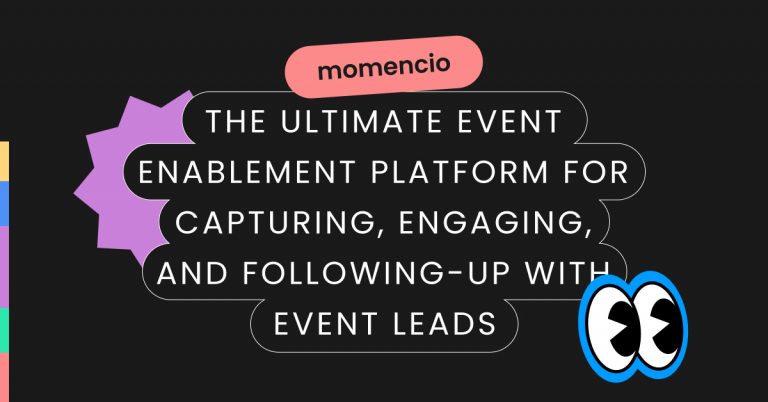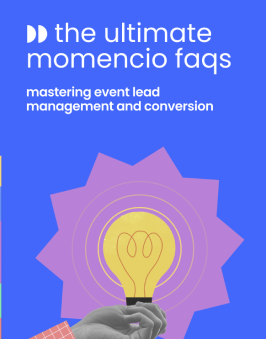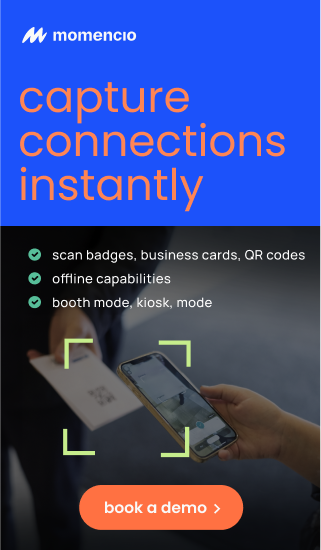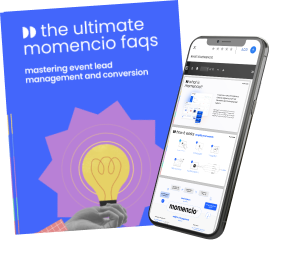When it comes to evaluating the success of an event, many organizers and marketers instinctively turn to financial metrics such as ROI. After all, numbers on a balance sheet seem like a definitive way to judge whether an event was worth it. But is ROI alone enough to capture the full scope of what makes an event successful? The short answer is no.
Events—whether they are conferences, trade shows, or product launches—offer much more than just an opportunity to generate immediate sales or gather leads. They are about brand building, fostering relationships, deepening customer engagement, and creating lasting impressions. If you only measure your event’s success in financial terms, you are likely missing out on the bigger picture.
While 70% event organizers measure ROI, only 52% assess attendee engagement and only 30% evaluate the quality of networking opportunities created. This indicates a significant gap between traditional financial assessments and the broader, more impactful outcomes of successful events.
Moreover, effective event budgeting plays a crucial role in both managing costs and driving non-financial success metrics. Allocating resources to areas such as attendee experience, sustainability initiatives, and technology not only influences the event’s ROI but also shapes how attendees perceive and engage with your brand.
In this article, we will dive deep into how to measure event success by going beyond the bottom line. From key budgeting considerations to advanced metrics that assess attendee satisfaction and engagement, we will guide you through a holistic approach to evaluating your event’s true impact.
Why financial ROI is not enough for measuring event success
Event ROI has long been the go-to metric for event organizers looking to measure success. It is straightforward: you calculate the revenue generated from the event and subtract the costs. The result tells you whether the event was financially worthwhile. However, while ROI is a critical indicator of an event’s economic performance, it falls short when assessing the true impact of your event.
A purely financial lens overlooks key aspects such as brand awareness, customer engagement, relationship building, and long-term business development. For example, events often provide the perfect setting for in-depth conversations that can deepen relationships with clients, partners, and prospects. These interactions may not immediately translate into revenue but can generate business opportunities months or even years later. Traditional ROI calculations do not account for this delayed impact.
get a comprehensive view of how well your events are performing financially with momencio’s event ROI calculators.
Another limitation of focusing solely on financial returns is the risk of undervaluing attendee experience. Many event planners miss the opportunity to allocate portions of their budget toward enhancing attendee satisfaction, engagement, and participation. By concentrating too much on financial returns, organizations often overlook the long-term value of creating memorable and impactful experiences that lead to increased brand loyalty and advocacy.
Moreover, relying solely on ROI can result in a narrow, short-term focus. While it is important to track immediate sales and leads generated, many events serve a larger strategic purpose—such as boosting brand visibility, launching new products, or educating a target audience. These outcomes may take longer to materialize and are difficult to quantify through direct financial metrics alone.
For instance, consider a product launch event. The initial ROI may not seem impressive, especially if most attendees are not yet ready to make a purchase. However, if the event succeeded in creating buzz around the product, positioning the brand as an industry leader, and building a pipeline of future prospects, it could deliver substantial value in the long run.
Key factors in event budgeting that influence success
An effective event budget does more than just keep spending under control—it directly shapes the success of your event. Thoughtful budgeting ensures that resources are allocated in a way that enhances the attendee experience, strengthens brand presence, and delivers long-term value beyond immediate financial returns. When aligned with broader event objectives, event budgeting becomes a strategic tool that maximizes impact.
-
Strategic allocation of resources
One of the most important factors in event budgeting is knowing where to allocate funds for maximum effect. Often, event planners must strike a delicate balance between investing in high-impact areas like technology, venue, or marketing, and controlling costs in others. For example, allocating a significant portion of your budget to event technology—such as attendee engagement platforms or real-time analytics tools—can offer long-term returns in the form of actionable insights and improved event performance. Meanwhile, other areas like catering or décor, though important, may have less direct influence on the success of the event and can be optimized without compromising quality.
This strategic allocation helps ensure that the key elements that drive success, such as high-quality presentations, engaging booths, or memorable attendee experiences, are well-supported financially. It is about focusing on the details that matter most to attendees and contribute directly to the event’s broader objectives.
-
Budgeting for attendee experience
Attendees are at the core of any event’s success, which means allocating a portion of the event budget to improve their experience is critical. Whether through interactive sessions, innovative technology, or personalized engagement, an event that prioritizes attendee satisfaction creates deeper connections with its audience.
For instance, investing in digital tools like mobile event apps allows for seamless communication, real-time updates, and engagement opportunities throughout the event. In-booth engagement strategies, such as gamification or personalized presentations, help create a more dynamic and memorable experience. While these investments may not show an immediate financial return, they play a significant role in shaping how attendees perceive your event and, by extension, your brand. A positive attendee experience can lead to stronger loyalty, higher return attendance rates, and word-of-mouth promotion.
-
Balancing costs and innovation
Innovation does not always require a large budget, but it does require careful planning. Many event organizers assume that implementing new ideas or technologies will push their budget over the limit. However, with the right approach, even a modest event budget can support innovative practices.
For example, instead of investing in expensive physical giveaways, consider allocating part of the budget toward digital content that provides ongoing value to attendees, such as follow-up materials, recorded sessions, or personalized microsites that extend engagement after the event has ended. Similarly, live polling, interactive presentations, or even virtual reality displays can enhance the event experience without necessarily demanding an extensive budget.
The key is finding ways to introduce fresh, creative ideas that make the event stand out without overspending. Attendees value unique and engaging experiences more than lavish but forgettable ones, and innovative approaches to budgeting can create lasting impressions that drive business results.
Event success metrics beyond the bottom line
To fully understand the success of an event, you must look beyond financial metrics and assess various aspects that contribute to its overall impact. These non-financial metrics provide a more holistic view of how the event performed in terms of engagement, brand recognition, and lead generation. By focusing on the following key success metrics, you can gather valuable insights that go beyond just revenue.
-
Attendee engagement and satisfaction
Measuring attendee engagement is one of the most critical indicators of event success. Attendees who are actively engaged are more likely to absorb information, participate in discussions, and form lasting impressions. Engagement can be tracked through several methods, including:
- Surveys and feedback forms: Post-event surveys are a direct way to measure attendee satisfaction. By asking targeted questions about the overall experience, the quality of the sessions, and the usefulness of networking opportunities, you can gain clear insights into what worked well and what can be improved.
- Participation levels: Track how many attendees participated in different activities, such as workshops, keynote sessions, or networking events. Metrics such as session attendance rates, live polling results, or social media activity can offer valuable indicators of attendee interest and engagement.
- Engagement analytics: Using event technology, such as mobile apps or engagement platforms, you can gather data on how attendees interacted with content during the event. This could include metrics like time spent in sessions, engagement with speakers, or interaction with sponsors.
When you prioritize attendee satisfaction, it strengthens the likelihood of attendees returning to future events and recommending the event to others. In turn, this contributes to long-term success.
-
Brand impact and awareness
Events offer a unique opportunity to increase brand visibility and enhance your organization’s reputation within the industry. Measuring brand impact requires a combination of quantitative and qualitative approaches.
- Media mentions and social media reach: Track how your event is discussed in the media, whether through traditional press coverage or social media mentions. Social listening tools can help monitor brand sentiment and gauge the level of interest and awareness your event generated.
- Branded content engagement: If your event included branded content, such as product demonstrations or presentations, tracking how often this content was accessed or shared can provide insight into how effectively the event increased awareness of your brand. Metrics like video views, article shares, or downloads of whitepapers are strong indicators of engagement with your brand.
A well-executed event can position your organization as a thought leader in your field, strengthen relationships with existing clients, and attract new prospects who may not have been familiar with your brand before.
-
Lead capture and conversion
Lead conversion is a key objective for many B2B events, making it crucial to measure how successful your event was in capturing and converting leads. While the quantity of leads is important, quality often matters more when assessing long-term value.
- Lead quality and scoring: Implement a lead scoring system to prioritize leads based on their potential to convert. This may involve evaluating the level of engagement, the attendee’s position within the company, or the types of sessions they attended.
- CRM integration and follow-up: Seamlessly integrating the data collected at the event with your CRM system is vital for post-event follow-up. Track how many leads were followed up, and measure conversion rates over time to see how successful the event was in driving business growth.
Effective lead generation and follow-up strategies not only improve short-term sales opportunities but also build a robust pipeline for future business.
-
Networking and partnerships
Beyond individual interactions, the relationships and partnerships formed at an event often define its success. Measuring the value of networking requires looking at both the quantity and quality of the connections made.
- New partnerships or collaborations: Post-event surveys can ask attendees about new business relationships or partnerships they formed during the event. Additionally, tracking any formal agreements or partnerships initiated as a result of the event can provide concrete data on its networking success.
- Attendee networking tools: Many event apps now offer built-in networking tools, allowing attendees to connect before, during, and after the event. By measuring the usage of these tools and tracking follow-up interactions, you can assess how effectively the event facilitated meaningful connections.
Strong networking opportunities at events not only enhance attendee satisfaction but can also result in long-term partnerships that extend far beyond the initial event.
The role of real-time analytics in measuring event success
Real-time analytics have transformed the way event organizers track and assess the performance of their events. With the ability to capture and analyze data as the event unfolds, organizers can make informed decisions on the spot, ensuring that they are optimizing the attendee experience and gathering actionable insights. The integration of real-time analytics into event management not only allows for immediate feedback but also enhances post-event evaluation, helping to fine-tune future strategies.
-
Using data to track engagement
Real-time analytics provide a wealth of information about attendee behavior throughout the event. From the moment attendees check in, their movements, session choices, and interactions can be monitored, allowing organizers to measure engagement levels in real time.
- Session attendance and participation: By tracking attendance numbers for each session and analyzing the duration of time attendees spend in sessions, organizers can identify the most popular topics, speakers, or formats. This data is valuable for optimizing content in future events.
- In-booth engagement: Exhibitors can benefit from tracking how long attendees spend at their booths, what products or services draw the most attention, and which engagement strategies (demos, presentations, etc.) are most effective. This helps exhibitors refine their approach for the remainder of the event and for future engagements.
- Audience interaction: Real-time tools such as live polling, Q&A platforms, and social media feeds allow organizers to measure how engaged attendees are during sessions. High interaction rates indicate that the content is resonating with the audience, while low engagement can signal the need for adjustments in delivery or content focus.
By actively monitoring these metrics, organizers can make adjustments during the event—whether that means modifying session structures, introducing more networking opportunities, or adjusting schedules to better meet the needs of attendees.
-
Leveraging event technology for deeper insights
The use of event technology platforms has grown exponentially, enabling event organizers to capture data that goes beyond attendance numbers. Tools such as mobile event apps, RFID badges, and beacon technology provide organizers with more granular data on attendee behavior.
- Mobile event apps: These apps allow organizers to track which sessions attendees have registered for, how they interact with the event’s agenda, and which exhibitors they visit. In addition, features like in-app surveys or live feedback tools enable organizers to gather immediate attendee insights, improving their understanding of attendee preferences and satisfaction levels.
- RFID and beacon technology: These tools provide even deeper insights into attendee behavior by tracking foot traffic across the event venue. Organizers can use this data to understand where attendees spend most of their time, which booths or zones attract the highest traffic, and how attendees move throughout the space. This information is crucial for optimizing floor plans, session locations, and booth setups.
By leveraging these technologies, organizers can gain a comprehensive view of how their event is performing in real time. This allows them to capitalize on high-engagement areas and address potential issues before they impact attendee satisfaction.
Post-event analysis: A comprehensive approach to measuring success
Once the event concludes, the process of evaluating its success truly begins. Post-event analysis is critical for gaining insights into what worked, what did not, and how to improve for future events. By taking a comprehensive approach to reviewing both the financial and non-financial outcomes, event organizers can develop a clearer understanding of the event’s overall impact.
-
Event budget review
The first step in post-event analysis is to review the event budget and assess whether the financial resources were allocated efficiently. Comparing the actual expenses against the initial budget plan helps identify areas of overspending or underfunding, providing valuable lessons for future events.
- Assessing budget alignment with goals: Determine whether the budget was aligned with the event’s key objectives. For instance, if attendee engagement was a primary goal, was enough of the budget dedicated to creating interactive experiences? If the goal was lead generation, did the budget prioritize tools and strategies that effectively captured and nurtured leads?
- Evaluating ROI: While financial ROI should not be the sole focus, it remains an important part of the overall evaluation. By calculating the event’s revenue and comparing it to the costs, organizers can determine the direct financial return. However, keep in mind that some of the event’s value may not be immediately visible, such as relationships built or brand visibility gained, which can pay dividends over time.
A thorough budget review helps ensure that resources were used efficiently and provides guidance on where future budgets can be adjusted for better results.
-
Post-event surveys and feedback
Gathering feedback from attendees, exhibitors, and stakeholders is one of the most effective ways to measure the overall success of an event. Post-event surveys allow you to directly ask participants about their experiences, satisfaction levels, and any areas for improvement.
- Attendee surveys: Ask attendees to rate various aspects of the event, such as the quality of sessions, networking opportunities, and overall event organization. Include open-ended questions that allow attendees to provide specific feedback and suggestions.
- Exhibitor and sponsor feedback: Exhibitors and sponsors are key stakeholders in any event. Gathering their input on booth traffic, lead generation success, and the overall quality of the event will help you understand their level of satisfaction and identify areas to enhance for future partnerships.
By carefully analyzing the feedback, event organizers can gain actionable insights that directly inform future planning, ensuring that each event improves upon the last.
-
Assessing long-term impact
One of the challenges in measuring event success is that some of the most important outcomes—such as relationships formed, brand recognition, or long-term business development—do not manifest immediately. Therefore, it is crucial to track the long-term impact of your event, well after it concludes.
- Repeat attendance and brand loyalty: One of the best indicators of an event’s long-term success is whether attendees return for future events. Tracking repeat attendees provides insight into how effectively the event fostered long-term relationships and loyalty.
- Brand perception over time: Monitor how the event contributed to changes in brand awareness and perception. This can be done through follow-up surveys, social media monitoring, or press coverage. Events that successfully position a brand as an industry leader can continue to deliver value long after they end.
- Conversion rates and lead nurturing: In many cases, leads generated at an event may not convert into sales immediately. It is important to track the progress of these leads through the sales pipeline. CRM integration plays a vital role in managing these long-term relationships, enabling sales teams to track interactions and nurture leads over time. Measuring conversion rates in the months following an event will provide a clearer picture of the event’s business impact.
By focusing on long-term outcomes, you can ensure that your event delivers sustained value and contributes to broader organizational goals.
Sustainability and CSR: Measuring the broader impact of your event
In recent years, sustainability and corporate social responsibility (CSR) have become increasingly important factors in event planning. Today’s attendees, sponsors, and stakeholders often expect events to align with environmentally friendly practices and contribute positively to society. Incorporating these elements into your event strategy not only enhances brand reputation but also provides additional ways to measure event success beyond traditional metrics.
-
Budgeting for sustainable practices
Integrating sustainability into your event requires intentional budget allocation. Sustainable practices do not necessarily mean higher costs; in fact, many eco-friendly solutions can help reduce overall expenses in the long term. Allocating resources toward sustainability not only demonstrates a commitment to CSR but also enhances the attendee experience.
- Eco-friendly materials: Use of recycled or biodegradable materials for event collateral, signage, and giveaways reduces the environmental impact of your event. Budgeting for sustainable alternatives such as digital swag or virtual event materials can also cut down on waste while offering attendees long-term value.
- Energy-efficient venues: Choosing venues that adhere to environmentally friendly standards, such as LEED certification, can make a significant difference in reducing the event’s carbon footprint. These venues often have systems in place to manage waste, energy use, and water conservation, helping organizers meet their sustainability goals.
- Paperless event tools: Digital tools such as mobile apps, e-tickets, and QR codes not only streamline event management but also reduce paper waste. Allocating budget toward technology solutions can help create a more seamless and environmentally conscious event experience.
Budgeting for sustainability initiatives ensures that your event reflects your organization’s commitment to minimizing its environmental impact while still delivering value to attendees.
-
CSR initiatives: Evaluating the social impact of your event
Corporate social responsibility goes beyond sustainability, encompassing initiatives that positively impact the community and society as a whole. Events offer an excellent platform for showcasing your organization’s commitment to CSR through partnerships with charities, inclusion initiatives, and community support programs.
- Partnering with local charities: Consider allocating part of your event budget toward charitable initiatives, such as donations to a local nonprofit or organizing volunteer activities for attendees. This not only creates a positive social impact but also strengthens relationships between your brand and the community.
- Diversity and inclusion efforts: Implementing diversity and inclusion initiatives within your event, such as accessible venues, diverse speakers, or scholarships for underrepresented groups, demonstrates your organization’s commitment to creating an inclusive environment. These efforts can be measured by tracking attendee demographics, engagement with inclusion-focused content, and feedback from attendees.
- Local sourcing and community engagement: Budgeting for local suppliers, vendors, and talent helps support the community in which the event takes place. This not only reduces the event’s carbon footprint (by minimizing transportation needs) but also promotes local economic growth.
CSR initiatives can create a deeper connection between your organization and attendees, enhancing your event’s reputation while contributing positively to society. Measuring the success of these initiatives often involves collecting qualitative feedback and tracking participation in charitable or community-focused activities.
-
Success metrics for sustainability and CSR
Measuring the success of sustainability and CSR initiatives requires a different set of metrics compared to traditional financial or engagement metrics. However, these metrics are crucial for understanding the broader impact of your event and ensuring alignment with your organizational values.
- Carbon footprint reduction: Track your event’s carbon footprint by calculating energy use, transportation emissions, and waste production. Tools and calculators are available to help estimate the environmental impact of various aspects of your event. A successful sustainability strategy would result in lower carbon emissions compared to previous events.
- Waste reduction: Measure the amount of waste generated during the event and how much of it was diverted from landfills through recycling or composting efforts. Events that successfully implement waste reduction strategies often see a significant decrease in overall waste output.
- Attendee feedback on CSR efforts: Gathering feedback from attendees on the event’s sustainability and CSR initiatives provides insights into how well these efforts were received. Attendees who appreciate and support your sustainability efforts are more likely to view your brand favorably and return for future events.
By measuring the broader impact of your event through sustainability and CSR metrics, you demonstrate a commitment to responsible business practices while enhancing the overall value of your event.
Integrating financial success with broader event goals
Financial success is only one component of a successful event. To achieve a more complete picture, event organizers must balance the financial returns with intangible metrics such as brand awareness, attendee engagement, and long-term business value. The key is to align your event budgeting with these broader goals, ensuring that both short-term and long-term objectives are met.
-
Balancing financial ROI with intangible metrics
Many events, especially those in B2B sectors, serve a broader purpose than just generating immediate revenue. While financial ROI remains important, intangible metrics such as attendee satisfaction, lead nurturing, and brand loyalty often carry more weight over the long term.
- Brand awareness: Events are powerful tools for increasing visibility and positioning a company as a thought leader. While this impact may not translate into immediate sales, it can lead to significant future business opportunities. Allocating a portion of the event budget toward marketing and branding efforts—such as high-quality content, eye-catching displays, or influential speakers—can help elevate your brand’s position within the industry.
- Attendee engagement: High levels of attendee engagement are closely tied to event success. The more actively attendees participate, the more value they derive from the event. Event budgeting should reflect this by investing in interactive elements, such as live polling, workshops, or networking platforms, which contribute to a more engaging and memorable experience.
- Lead nurturing: Events often generate leads that require careful nurturing before they convert into business opportunities. Allocating resources for post-event follow-up, CRM integration, and content tailored to different stages of the sales funnel can ensure that leads are effectively nurtured toward conversion.
Balancing financial and intangible metrics allows event organizers to focus on long-term value rather than short-term gains.
-
Measuring long-term business value
To truly assess the success of an event, it is essential to measure its impact beyond the immediate outcomes. Some of the most valuable metrics, such as repeat business, long-term partnerships, and increased brand loyalty, may not manifest until well after the event has ended.
- Client retention and repeat business: Tracking how many attendees return to future events or engage with your business after the event is a strong indicator of success. Loyal attendees and clients are often the result of a positive event experience, and these long-term relationships are critical for sustained business growth.
- Business partnerships: Many events serve as networking hubs, facilitating the formation of strategic business partnerships. Measuring the number of new partnerships or collaborations initiated at the event provides a clear indication of its broader business impact.
- Brand perception and market positioning: Monitoring how your brand is perceived within the market after the event is a valuable way to assess its long-term influence. Social listening tools, customer feedback, and industry mentions are all effective methods for gauging whether the event succeeded in positioning your brand as an industry leader.
-
Adjusting event budgeting strategies for future success
The insights gained from each event should directly influence how future event budgets are allocated. By reviewing both financial and non-financial metrics, you can identify where resources were most effectively spent and where adjustments need to be made.
- Optimizing budget allocation: Did investing in attendee engagement tools drive better results than expected? Was there a particular aspect of the event that exceeded expectations in terms of ROI or attendee satisfaction? Use these insights to reallocate funds for future events, ensuring that your budget aligns with the areas that provide the highest impact.
- Planning for scalability: As your events grow, you may need to scale up certain aspects of your budget while streamlining others. For instance, if virtual or hybrid events become a more permanent part of your strategy, ensure that your budget reflects the additional resources needed to deliver a seamless digital experience while potentially reducing costs in areas such as travel or physical venue expenses.
- Continuous improvement: The key to long-term event success is continuous refinement. By incorporating lessons learned from each event, you can create a budget that not only controls costs but also drives ongoing improvements in attendee experience, engagement, and brand loyalty.
Balancing financial ROI with broader event goals requires thoughtful planning and strategic budgeting. By focusing on long-term business value and adjusting your budget based on past performance, you can ensure that future events deliver sustained success.
Conclusion
Measuring the success of an event requires more than just calculating financial ROI. While revenue generation is important, focusing solely on financial metrics overlooks the broader impact that events can have on your business. To gain a holistic view of event success, you must consider a range of non-financial metrics, such as attendee engagement, brand awareness, lead generation, and the long-term business value created by networking opportunities and partnerships.
Event budgeting plays a critical role in aligning financial resources with these broader goals. By strategically allocating your budget toward attendee experience, innovative engagement strategies, sustainability practices, and lead nurturing efforts, you can create an event that delivers not only short-term financial gains but also long-term growth and brand loyalty.
Real-time analytics, post-event surveys, and long-term tracking are essential tools for gathering the insights needed to measure success across all these dimensions. By continuously refining your budgeting and event planning processes based on the insights gained, you can ensure that each event contributes to your broader business objectives.
In the end, successful events are those that strike a balance between financial performance and intangible outcomes, positioning your brand for long-term success and fostering deep, lasting connections with your audience.
FAQs
- What are the key metrics to measure event success beyond financial ROI?
- Key metrics include attendee engagement, brand awareness, lead generation, networking opportunities, and long-term business impact. These metrics give you a more complete view of how successful your event was, going beyond just financial performance.
- How can I ensure my event budgeting aligns with both financial and non-financial success metrics?
- To ensure your event budget aligns with broader success metrics, allocate resources strategically. Invest in attendee experience, engagement tools, sustainability efforts, and technology for real-time data analysis. This ensures that both financial goals and intangible outcomes, such as brand awareness and attendee satisfaction, are addressed.
- Why is post-event analysis important in evaluating success?
- Post-event analysis provides critical insights into what worked and what did not. It helps event organizers refine their strategies for future events by gathering feedback from attendees, exhibitors, and stakeholders. It also allows you to track long-term impacts, such as lead conversion and repeat attendance, that may not be immediately apparent.
- How can real-time analytics improve event success measurement?
- Real-time analytics allow you to monitor attendee behavior and engagement during the event, offering immediate insights that can help you make on-the-spot adjustments. This data can also be used to optimize future events by identifying popular sessions, improving floor plans, and enhancing engagement strategies.
- How do sustainability and CSR initiatives contribute to event success?
- Sustainability and CSR initiatives enhance your event’s broader impact by aligning with attendees’ values and contributing to positive social or environmental outcomes. Budgeting for sustainability and CSR efforts demonstrates your organization’s commitment to responsible practices and can improve brand reputation and attendee satisfaction.



